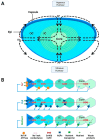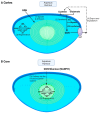Minimizing Oxidative Stress in the Lens: Alternative Measures for Elevating Glutathione in the Lens to Protect against Cataract
- PMID: 39456447
- PMCID: PMC11505578
- DOI: 10.3390/antiox13101193
Minimizing Oxidative Stress in the Lens: Alternative Measures for Elevating Glutathione in the Lens to Protect against Cataract
Abstract
Oxidative stress plays a major role in the formation of the cataract that is the result of advancing age, diabetes or which follows vitrectomy surgery. Glutathione (GSH) is the principal antioxidant in the lens, and so supplementation with GSH would seem like an intuitive strategy to counteract oxidative stress there. However, the delivery of glutathione to the lens is fraught with difficulties, including the limited bioavailability of GSH caused by its rapid degradation, anatomical barriers of the anterior eye that result in insufficient delivery of GSH to the lens, and intracellular barriers within the lens that limit delivery of GSH to its different regions. Hence, more attention should be focused on alternative methods by which to enhance GSH levels in the lens. In this review, we focus on the following three strategies, which utilize the natural molecular machinery of the lens to enhance GSH and/or antioxidant potential in its different regions: the NRF2 pathway, which regulates the transcription of genes involved in GSH homeostasis; the use of lipid permeable cysteine-based analogues to increase the availability of cysteine for GSH synthesis; and the upregulation of the lens's internal microcirculation system, which is a circulating current of Na+ ions that drives water transport in the lens and with it the potential delivery of cysteine or GSH. The first two strategies have the potential to restore GSH levels in the epithelium and cortex, while the ability to harness the lens's internal microcirculation system offers the exciting potential to deliver and elevate antioxidant levels in its nucleus. This is an important distinction, as the damage phenotypes for age-related (nuclear) and diabetic (cortical) cataract indicate that antioxidant delivery must be targeted to different regions of the lens in order to alleviate oxidative stress. Given our increasing aging and diabetic populations it has become increasingly important to consider how the natural machinery of the lens can be utilized to restore GSH levels in its different regions and to afford protection from cataract.
Keywords: Nrf2; cataracts; cystine/cysteine; glutathione; lens microcirculation system.
Conflict of interest statement
J.C.L. and P.J.D. have collaborated with Nacuity Pharmaceuticals, Inc. in the testing of NACA and diNACA analogues on the lens.
Figures




Similar articles
-
Spatial distributions of glutathione and its endogenous conjugates in normal bovine lens and a model of lens aging.Exp Eye Res. 2017 Jan;154:70-78. doi: 10.1016/j.exer.2016.11.008. Epub 2016 Nov 9. Exp Eye Res. 2017. PMID: 27838309 Free PMC article.
-
Age-dependent changes in glutathione metabolism pathways in the lens: New insights into therapeutic strategies to prevent cataract formation-A review.Clin Exp Ophthalmol. 2020 Nov;48(8):1031-1042. doi: 10.1111/ceo.13801. Epub 2020 Jun 15. Clin Exp Ophthalmol. 2020. PMID: 32462803 Review.
-
Lens glutathione homeostasis: Discrepancies and gaps in knowledge standing in the way of novel therapeutic approaches.Exp Eye Res. 2017 Mar;156:103-111. doi: 10.1016/j.exer.2016.06.018. Epub 2016 Jun 29. Exp Eye Res. 2017. PMID: 27373973 Free PMC article. Review.
-
N-Acetylcysteine amide (NACA) and diNACA inhibit H2O2-induced cataract formation ex vivo in pig and rat lenses.Exp Eye Res. 2023 Sep;234:109610. doi: 10.1016/j.exer.2023.109610. Epub 2023 Aug 1. Exp Eye Res. 2023. PMID: 37536438
-
Redox Homeostasis in Ocular Tissues: Circadian Regulation of Glutathione in the Lens?Antioxidants (Basel). 2022 Aug 3;11(8):1516. doi: 10.3390/antiox11081516. Antioxidants (Basel). 2022. PMID: 36009235 Free PMC article. Review.
Cited by
-
Restoring Glutathione Homeostasis in Glycation-Related Eye Diseases: Mechanistic Insights and Therapeutic Interventions Beyond VEGF Inhibition.Antioxidants (Basel). 2025 Jun 14;14(6):731. doi: 10.3390/antiox14060731. Antioxidants (Basel). 2025. PMID: 40563363 Free PMC article. Review.
-
Association of triglyceride-glucose index and derived indices with cataract in middle-aged and elderly Americans: NHANES 2005-2008.Lipids Health Dis. 2025 Feb 14;24(1):48. doi: 10.1186/s12944-025-02470-4. Lipids Health Dis. 2025. PMID: 39953544 Free PMC article.
-
Pharmacological Strategies for Cataract Management: From Molecular Targets to Clinical Translation.Int J Mol Sci. 2025 Jun 13;26(12):5658. doi: 10.3390/ijms26125658. Int J Mol Sci. 2025. PMID: 40565122 Free PMC article. Review.
-
Mechano-activated connexin hemichannels mediate intercellular glutathione transport and support lens redox homeostasis.Redox Biol. 2025 Jul 14;85:103767. doi: 10.1016/j.redox.2025.103767. Online ahead of print. Redox Biol. 2025. PMID: 40669209 Free PMC article.
References
-
- Age-Related Eye Disease Study Research G. A randomized, placebo-controlled, clinical trial of high-dose supplementation with vitamins C and E and beta carotene for age-related cataract and vision loss: AREDS report no. 9. Arch. Ophthalmol. 2001;119:1439–1452. doi: 10.1001/archopht.119.10.1439. - DOI - PMC - PubMed
Publication types
Grants and funding
LinkOut - more resources
Full Text Sources

